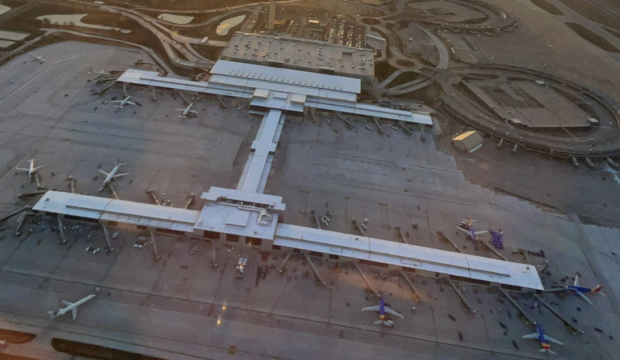HOME | ABOUT US | MEDIA KIT | CONTACT US | INQUIRE
HOME | ABOUT US | MEDIA KIT | CONTACT US | INQUIRE
Kansas City checks a big box on its civic to-do list with the next-generation airport up and running.

Transformational. If there’s a word invoked by business leaders, travelers, and city aviation officials, that’s the word that describes the new Kansas City International Airport, which opened a few weeks ahead of schedule in February, slightly less than three years after its groundbreaking.
Half a century of Kansas City aviation history wrapped up at 12:48 a.m. Feb. 28, with the last plane arriving at the former Terminal B. With that, aviation officials began closing both B and C terminals as the city moved into a new air-travel era. Both of those terminals will soon meet the fate of the former Terminal A, which was razed to accommodate the new single-terminal configuration.
With at least 39 gates to start, expandable as demand warrants, the 1.1 million-square-foot terminal will feature 16 dedicated security lanes, with a greatly enhanced experience for travelers who pass through those checkpoints.
Edgemoor Infrastructure and Real Estate of Bethesda, Md., leading the project; construction was completed by a joint venture—Clark | Weitz | Clarkson—that included Kansas City’s Clarkson Construction.
“From the outset, we committed to making this project transformational by building the capacity of small, minority- and women-owned businesses and training men and women to be part of the workforce of the future,” said Geoffrey Stricker, Edgemoor’s senior managing director. “We have exceeded all project goals and are extremely proud of what the team has accomplished.”
Kyle O’Neal, an official with Southwest Airlines, hailed the promise of change at the groundbreaking in 2018. “The new terminal,” he said, “will support more efficient airline operations and allow airport users to enjoy the convenience of modern air travel in a facility with updated technology and amenities, close parking, spacious gate areas, and ample food and beverage options.”
All told the airport project generated roughly 5,000 construction-related jobs; more than 240 Kansas City-area firms had a piece of that work. More than 130 of those were minority- and women-owned businesses as the project exceeded its ambitious diversity goals.
The new facility offers more than two dozen dining options and close to a score of specialty retailers. Other amenities include a quiet room, a business center, a play zone for children, and plenty of bathrooms—a deficiency in the old terminals that was frequently cited by travelers. There’s even an outdoor animal relief area.
Designers pushed the edge of practically every conceivable envelope, incorporating themes that reflect Kansas City’s reputation as the City of Fountains and its roots in jazz music and as a barbecue capital of America. In addition, public art received a high priority, with $5.6 million invested in sculptures, paintings, and other works by 28 artists—19 of whom live in the area or have local ties.
Interestingly enough, the $1.5 billion price tag comes in well below the inflation-adjusted $1.83 billion it cost to build the predecessor airport, which opened in 1972. The timing of that proved a thorn in the side of aviation officials for decades, coming just ahead of a wave of plane hijackings that transformed the need for security, leading up to the terrorist attacks of Sept. 2001, which led to a complete rewrite of that playbook.
Despite a $240 million upgrade in 2004, adding a few restrooms and sandwich/drink options behind the security barriers, the three-terminal construction was an increasing irritation to Kansas City’s community of frequent business travelers. While individuals remained loyal to the old model, thanks to its convenience—gates were designed to be within 75 feet of parking garages—business leaders and economic development professionals said the region was losing the ability to attract new companies because using the airport was such an unpleasant experience.
Civic leaders had long suggested that an upgraded KCI would prompt airlines to rethink their service lines to Kansas City. They were quickly validated this spring as Southwest Airlines—the 800-pound gorilla of carriers here, with roughly half the arrivals and departures—announced a resumption of flights to Indianapolis and Albuquerque, which had been canceled during the plummeting demand during the Covid-19 pandemic.
It also is increasing the frequency of flights to Atlanta, Los Angeles, San Diego, and St. Louis, and this summer says it will add more flights to Las Vegas, Pensacola, Fla., and Orlando, as well as seasonal service to Milwaukee, Minneapolis, and San Antonio starting in July.
Even international travel is seeing an immediate boost: Southwest is adding service to Sangster International Airport in Montego Bay, Jamaica, and to Los Cabos International Airport in San José del Cabo, Mexico while expanding non-stop service to Cancun International Airport.